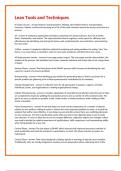Lean Tools and Techniques
8 wastes of Lean - answer-Defects, Overproduction, Waiting, Non-Utilized Talent, Transportation,
Inventory, Motion, and Extra-Processing are a list of the most common reasons for excess cycle time in a
process.
5S - answer-A workplace organization technique composed of 5 primary phases: Sort, Set In Order,
Shine, Standardize, and Sustain. The steps describes how to organize a work space for efficiency and
effectiveness by identifying and storing the items used, maintaining the area and items, and sustaining
the new order.
5 Whys - answer-A simple but effective method of analyzing and solving problems by asking "why" five
times, or as many times as needed in order to move past symptoms and determine root cause.
A3/Improvement charter - answer-A one page project report. This one-pager contains the problem, the
analysis of the process, the identified root causes, potential solutions and action plan all on a large sheet
of paper.
Analyze Phase - answer-The third phase of the DMAIC process which focuses on identifying the root
cause (or causes) of a process problem.
Brainstorming - answer-A free-thinking group method for generating ideas to find a conclusion for a
specific problem by gathering a list of ideas spontaneously contributed by its members.
Change Management - answer-A collective term for all approaches to prepare, support, and help
individuals, teams, and organizations in making organizational change.
Cellular Manufacturing - answer-A modern adaptation of assembly line production whereby sets of tasks
are completed by teams by splitting the production process into a number of self-contained units. The
goal is to move as quickly as possible, make a wide variety of similar products, while making as little
waste as possible.
Paired Comparisons - answer-A tool that helps you work out the importance of a number of options
relative to one another, making it easier to choose the most important problem to solve, or to pick the
solution that will be most effective. It also helps you set priorities where there are conflicting demands
on your resources. The tool is particularly useful when you don't have objective data to use to make
your decision. It's also an ideal tool to use to compare different, subjective options, for example, where
you need to decide the relative importance of qualifications, skills, experience, and teamworking ability
when hiring people for a new role.
Control Phase - answer-The last phase of DMAIC which ensures that improved processes continue to
work predictably and meet the customers' expectations. In short, this phase ensures any gains are
maintained.
Control Chart - answer-Time charts designed to display signals or warnings of special cause variation.
Traditionally, they are mostly designed to monitor process parameters when underlying form of the
, process distributions are known. The purpose is to determine whether a process should undergo a
formal examination for quality-related problems.
Control Plan - answer-A guide to continued monitoring of the process, and the response plan for each of
the measures being monitored. The team should use this to ensure that the process does not slip back
into the ways of the old process.
Critical to Quality (CTQ) - answer-Internal critical quality parameters that relate to the wants and needs
of the customer. It is what's important to the quality of the process or service to ensure the things that
are important to the customer.
Customer - answer-The groups or individuals who receive the goods and services of of the process.
Cycle Time - answer-The measurement of the time elapsed from the beginning of a process or a step to
its end.
Data Collection - answer-The process of gathering and measuring information on targeted variables in
an established system, which then enables one to answer relevant questions and evaluate outcomes.
The goal is to capture quality evidence that allows analysis to lead to the formulation of convincing and
credible answers to the questions that have been posed.
Defect - answer-Any process output, product, or service that does not meet customer requirements.
One of the 8 Wastes.
Defective - answer-Term applied to any process, product, or service with one or more defects.
Define Phase - answer-The first phase of the DMAIC method which involves defining the problem or
opportunity, determining the voice of the customer/customer requirements, and outlining the project
purpose/scope.
DMAIC - answer-A data-driven improvement cycle used for improving, optimizing and stabilizing
business processes and designs. Stands for Define, Measure, Analyze, Improve, and Control.
Over-processing - answer-Refers to the concept of adding more features or producing a product or
service of higher quality than required by the customer. One of the 8 Wastes.
Facilitator/Facilitation skills - answer-An intermediary who helps parties involved in a process
improvement project collaborate. Can either be a third party or a team member/leader. Esssential skills
of what organizational development professionals refer to as the process of group facilitation
Failure Modes & Effects Analysis (FMEA) - answer-A risk management tool that identifies and quantifies
the influence of potential failures in a system. The tool evaluates the severity, occurrence and detection
of risks to prioritize which ones are the most urgent.
Fishbone Diagram - answer-A structured brainstorming tool designed to assist an improvement team in
listing potential causes of a specific effect. Also called cause- and effect diagram.




